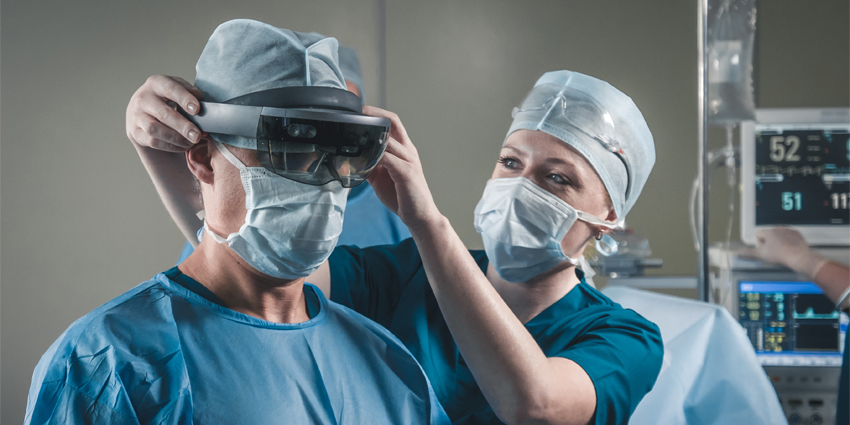The potential extended reality has for the healthcare industry is insurmountable. Imagine an elderly person being able to immediately access help from a doctor and get guided advice on how to deal with a help issue in seconds. Or consider what it would be like to have medical students train using virtual tools, rather than expensive cadavers?
Already, around 82% of medical professionals today agree that XR will successfully remove the hurdle of distance in accessing better healthcare.
Of course, for many medical teams, something like virtual reality, or a mixed reality headset, is an expensive investment – one difficult to justify when you’re running on a low budget.
That’s why it’s so important to have a strategy for building your business case for XR in healthcare. Here are some pointers to get you started.
1. Demonstrate the Impact on Education
By 2026, experts say the combined value of AR and VR in the global healthcare industry will reach around $10.82 billion, and it’s easy to see why. Extended Reality is already making a major impact on the way we help patients and support employees alike.
For instance, virtual reality in healthcare can be an excellent tool for medical professionals who need to develop their skills through the repetitive completion of procedures.
With a virtual reality headset, it’s possible for medical students to perform a range of procedures, without having to worry about wasted resources.
There’s also the option for multiple students to continue improving their education when they’re not able to visit a theatre or classroom in person – improving the chances of ongoing, retained skill.
One study conducted at the UCLA even found that surgeons who train using VR goggles are up to 20% faster in their tasks and complete up to 38% more steps correctly.
2. Highlight the Value on Patient Care
Extended reality presents incredible value for patient care, in a number of different settings. The use of MR and VR apps would allow for doctors and surgeons to check in on patients regardless of where they are and offer an immersive telemedicine experience.
Combined with other advanced technologies like digital twins, AI, and wearable health monitors, it could even be possible to conduct aspects of a physical examination at a distance.
Augmented Reality, and Virtual Reality, could also be useful in improving self-care amount patients. Doctors and care professionals could create their own rehabilitation apps to help individuals move through the recovery process as effectively as possible after a surgery. VR devices are also being used for things like reducing feelings of stress or fear when people are undergoing a medical treatment.
XR devices can also be extremely useful in giving doctors and healthcare professionals the extra data they need to provide more accurate and effective treatments. For instance, with a VR solution, a surgeon could potentially map the body of a patient before starting a surgery, to plan for any potential issues they might encounter.
3. Examine Treatment and Surgical Opportunities
Virtual, Augmented, and Mixed realities have all begun to have an impact on the treatment and surgical landscape in healthcare. As early as 2017, a VR technology assisted a chief of medical paediatric surgery to perform an incredible difficult procedure separating conjoined twins.
Headsets and augmented reality applications are helping with the management of a lot of different kinds of mental health treatments too. People with dementia and Alzheimer’s disease can use these tools to help them remember important feelings and moments from their lives.
Those with depression and stress can use similar tools to learn how to overcome their fears and improve their relaxation techniques, without exposing themselves to potentially worrying situations.
Some medical professionals are even beginning to look at extended reality as a solution for managing things like chronic pain in individuals with life-long conditions.
More research is currently underway to discover how XR solutions can help with various forms of treatment in the medical landscape.
4. Look at Productivity and Collaboration
The right extended reality applications can even improve how team members in a healthcare setting work together. For instance, in Germany, a start-up named Goodly Innovations developed an AR suite for biopharma and pharma manufacturing which helped technicians to increase their productivity.
In various landscapes, extended reality can help team members to visualize data more effectively and use those visualisations to explore potential treatment solutions or cures.
We already saw an example of this in the VR technology used to help scientists seek out a cure for the COVID-19 pandemic.
Another way XR can make teams more productive, is by improving the way they work together. In today’s modern healthcare landscape, many specialists are working collaboratively with each other from a range of different destinations.
Through virtual reality, specialists could share data and information in real-time, or even work on complex pharmaceutical projects together.
5. Consider the Marketing Opportunities
There are even benefits for medical companies and medical device brands who need to sell their technology to groups around the world. Leveraging XR can help to improve the understanding consumers have of how certain treatments and products might work.
Facilitating good communication between pharmaceutical companies, medical professionals, and device manufacturers will be crucial in helping healthcare groups to make the right decisions going forward.
Amazing demonstrations which allow professionals to go behind the scenes of a new product or drug to really see how it work should help the major stakeholders of life science companies to make intelligent decisions.
This will also ensure the creators of innovative new product sin the healthcare space get the right attention directed towards their solutions.
For instance, when making a new surgical instrument, a company could allow a surgeon to step into a simulation and test how the device works.
The possibilities for XR in healthcare are endless. Once you begin to look into the outcomes already happening in the landscape, creating your business case is much easier.







